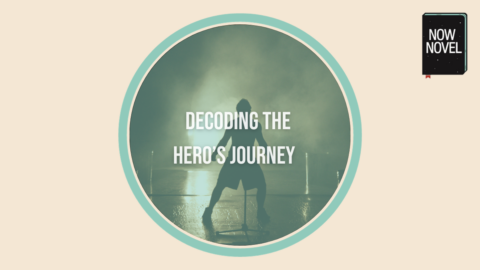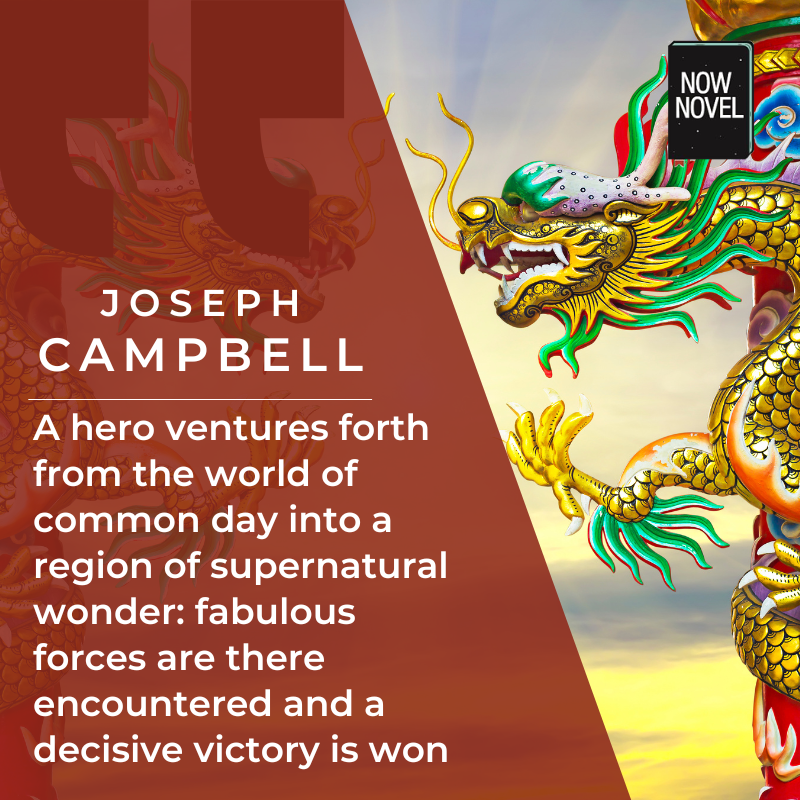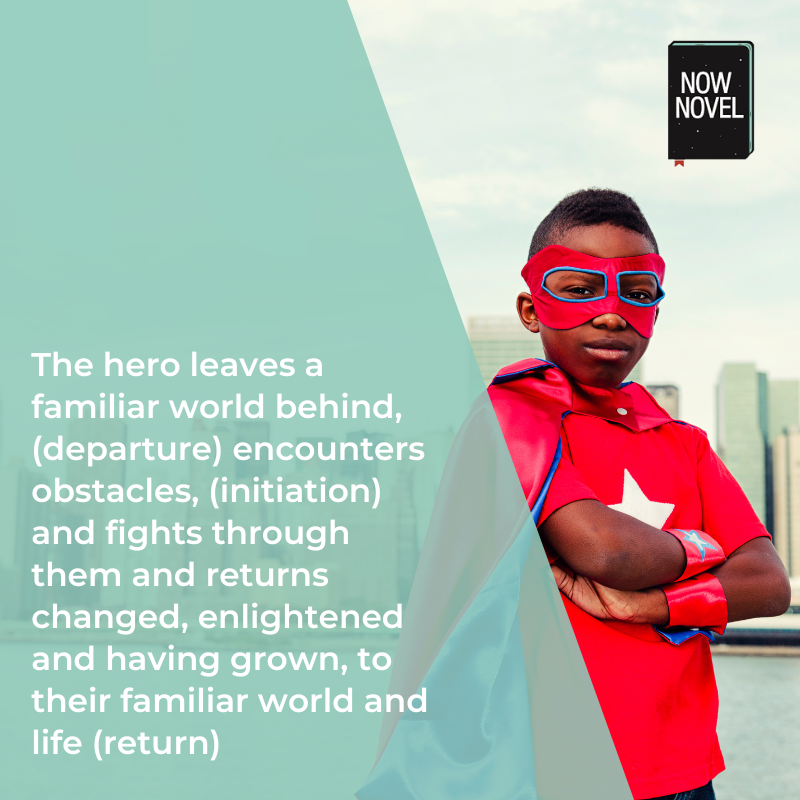Whether you’re a fan of mythology or simply interested in the art of storytelling, let’s delve into the world of the Hero’s Journey.
What is the Hero’s Journey or the monomyth?
The Hero’s Journey is a widely recognised pattern of storytelling and is essentially a circular storytelling journey. It follows a hero setting out on a journey of transformation, often into the unknown, there is often fierce resistance, and many trials and challenges, before the hero returns to their known world. It’s also called a “monomyth” as it’s the story of the archetypal hero shared by the world’s mythologies. It was first identified by Joseph Campbell in his book The Hero with a Thousand Faces (1949), who was in turn influenced by Carl Jung’s psychological perspective of models of self-transformation.
In his book Joseph Campbell described the journey a hero takes:
A hero ventures forth from the world of common day into a region of supernatural wonder: fabulous forces are there encountered and a decisive victory is won: the hero comes back from this mysterious adventure with the power to bestow boons on his fellow man.
Campbell identified 17 stages of the hero’s journey, which are explored in more detail below.
I Departure stage
- The Call to Adventure
- Refusal of the Call
- Supernatural Aid
- The Crossing of the First Threshold
- Belly of the Whale
II Initiation stage
- The Road of Trials
- The Meeting with the Goddess
- Woman as the Temptress
- Atonement with the Father
- Apotheosis
- The Ultimate Boon
III Return
- Refusal of the Return
- The Magic Flight
- Rescue from Without
- The Crossing of the Return Threshold
- Master of the Two Worlds
- Freedom to Live
The Hero’s Journey in fairy tales, folklore and film
To get a better idea of what this means let’s look at some examples. There are countless stories that reference this common story structure. The hero’s journey can be found in well-known fairy tales and folklore such as Hansel and Gretel, Little Red Riding Hood and Cinderella. In Greek literature there’s the famous poem, “The Odyssey” attributed to Homer. This tells of the hero Odysseus, King of Ithaca, who wanders for 10 years (although the action of the poem covers only the final six weeks) trying to get home after the Trojan War.
Charlotte Bronte’s novel, Jane Eyre is an example of a female hero in literature. From an orphaned childhood to life as a governess, this novel follows Jane’s journey to her eventual marriage.
For more on the feminist hero’s journey, there is a detailed look at the female hero’s journey popularised by psychologist Maureen Mudock. Also explore From Girl to Goddess: The Heroine’s Journey Through Myth and Legend (2010) by Valerie Estelle Frankel. This book explores the universal heroine’s journey as she quests through world myth.
Other books that use the Hero’s Journey as a frame include Ursula Le Guin’s The Left Hand of Darkness which tells the story of a lone human emissary to Winter, an alien world whose inhabitants spend most of their time without a gender. His goal is to facilitate Winter’s inclusion in a growing intergalactic civilization. But to do so he must bridge the gulf between his own views and those of the completely dissimilar culture that he encounters.
Then there’s The Hunger Games by Suzanne Collins. Set in the future of what was North America lies the nation of Panem. The Capitol is harsh and cruel and keeps the districts in line by forcing them all to send one boy and one girl between the ages of twelve and eighteen to participate in the annual Hunger Games, a fight to the death on live TV. It is centered on 16-year-old Katniss who volunteers for the Games in place of her sister, Primrose.
The Lord of the Rings by J.R.R. Tolkien is another example. Set in the fictional world of Middle-earth, the stories follow the hobbit Frodi Baggins as he and the Fellowship embark on a quest to destroy the One Ring to ensure the destruction of its maker, the Dark Lord Sauron.
In film Luke Skywalker’s journey toward Jedi Knighthood in the original Star Wars films is another example of the Hero’s Journey.
The Matrix (1999) is another example of the hero’s journey on the silver screen. In this sci-fi tale Keanu Reeves plays Neo, a man who joins a group of insurgents in their fight against the powerful computers who rule Earth.
The hero’s journey can be found in well-known fairy tales and folklore such as Hansel and Gretel, Little Red Riding Hood and Cinderella.
Tweet This
Embark on Your Authorial Odyssey
The hero’s journey isn’t just for myths; it’s for writers too! Join our ‘180-day Author’ program and journey through your novel with a band of fellow writers. Receive personalized coaching, invaluable feedback, and access to exclusive writing sprints. Transform your idea into a triumphant manuscript!
Start Quest
Three main stages
So, generally speaking, the common theme in a hero’s journey is represented by the three main stages of departure, initiation and return. And, as with so many stories, transformation, and growth is at the heart of the journey. The hero leaves a familiar world behind, (departure) encounters obstacles, (initiation) and fights through them and returns changed, enlightened and having grown, to their familiar world and life (return). It’s a journey fraught with challenges and trials, as well as encounters with enemies.
The 17 steps of the Hero’s Journey
Let’s take a closer look at these stages:
I Departure
- The Call to Adventure: We meet the hero in their familiar world living their normal life. They receive a call to go exploring an unfamiliar world. Campbell says this region can take the place of a distant land, or even a place that is not recognisably realistic, the sky, underground, even a dream state.
- Refusal of the Call: Understandably, they don’t want to answer the call and leave all that is familiar. But something compels them to answer it: perhaps life has become meaningless or perhaps they feel inadequate to the task.
- Supernatural Aid: Once the hero has accepted the call, they receive supernatural aid in the form of a mentor, who may give them special amulets or talismans to help them.
- The Crossing of the First Threshold: The hero takes that first step into that unfamiliar world, the darkness of what is not known and the quest begins.
- Belly of the Whale: There’s no going back, now. The title of this stage is likened to the Biblical story of Jonah in the belly of the whale. There is also now an expectation of re-birth.
II Initiation
- The Road of Trials: The hero now undergoes a series of tests or challenges which must be overcome. Here the dragons must be slain, they may call upon the talismans given to them at the start of the journey.
- The Meeting with the Goddess: The hero meets someone who will help them on the journey, a metaphorical “goddess” and is given items to help them navigate the path ahead.
- Woman as the Temptress: Again, the figure of a woman is a metaphorical one, the hero will face temptations that may lead them astray and want to abandon it all.
- Atonement with the Father: Here too the father figure can be a metaphorical one, and could be regarded as a person with great power. The hero gains an understanding of what is stopping them from achieving this goal. This is the beginning of the “end”, all steps from here lead outward to an eventual conclusion.
- Apotheosis: This can be visualized as rising action. A point of realization and understanding has been achieved. This equips the hero to continue on their journey.
- The Ultimate Boon: The quest has been achieved, they have answered or fulfilled the goal set out at the beginning of the story.
III Return
- Refusal of the Return: Having found enlightenment, answered the call, discovered a new world, the hero may be reluctant to return to the “mundane” world they knew.
- The Magic Flight: This is when escape beckons. The hero might need to leave with world with the “boon” they have found. This may be a dangerous escape as the gods might be jealously guarding such a treasure.
- Rescue from Without: The hero may need help getting out of this world, just as they received help entering this world.
- The Crossing of the Return Threshold: The hero returns to their regular world, armed with the new knowledge or realization they gained on the journey.
- Master of the Two Worlds: This represents a balance between the two worlds, a uniting of two worlds or a balance between spiritual and material needs.
- Freedom to Live: The quest has been achieved, this is the resolution of the journey.
Your Personal Writing Mentor
Every hero needs a guide. With our private coaching, get bespoke support on your storytelling quest. Our experienced coaches offer feedback, encouragement, and editorial wisdom to help you navigate the trials and triumphs of writing your story.

What are the (condensed) 12 steps of the Hero’s Journey?
In contrast to Campbell’s 17 stages, is screenwriter’s Christopher Vogler who created a 12-step hero’s journey and authored the screenwriting guide, The Writer’s Journey: Mythic Structure For Writers which takes the 17 stages as inspiration. It’s a more condensed version and the stages are:
- Ordinary World
- Call to Adventure
- Refusal of the Call
- Meeting the Mentor
- Crossing the First Threshold
- Tests, Allies, Enemies
- Approach to the Inmost Cave
- Ordeal
- Reward (Seizing the Sword)
- The Road Back
- Resurrection
- Return with the Elixir
Counter-arguments to Campbell’s Hero’s Journey
There has been criticism of Campbell’s Hero’s Journey, and it’s worth looking at these briefly.
American folklorist Barre Toelken noted that, “Campbell could construct a monomyth of the hero only by citing those stories that fit his preconceived mold, and leaving out equally valid stories… which did not fit the pattern.” Others have said that it is too broad and general, leading to oversimplification of complex narratives. Not all stories can be neatly forced into the prescribed stages of the Hero’s Journey.
In looking at today’s post-modern storytelling landscape, it can be argued that the Hero’s Journey it is too simplistic. In today’s writing, traditional may be deconstructed or subverted.
The Hero’s Journey follows a strictly linear structure – not all stories follow this structure and it doesn’t always support compelling stories. Non-linear or fragmented storytelling wouldn’t fit this framework, for example. Some writers do not follow linear structures.
There is a decided male-centric bias, with Campbell often centering on a male protagonist in his description of the monomyth. However, as described above, the Hero’s Journey has been used by women writers writing female-centric characters. So one could argue that the monomyth is infinitely adaptable. However, another criticism that is aligned with this is that the Hero’s Journey does not focus on collective or group heroism – but again, this form seems suited to be adapted to that kind of story, too.
Some argue that the Hero’s Journey places more emphasis on external events and challenges rather than on the internal growth and development of the hero. However, the framework in a novel such as Jane Eyre also focuses on a woman’s inner development and growth, so the form does prove to be adaptable.
Refine Your Heroic Story
Every epic tale needs polishing. Our editing services help you refine your manuscript, ensuring your story shines. From developmental editing to proofreading, we provide the critical eye and skilled touch needed to elevate your novel. Transform your draft into a manuscript worthy of the hero’s journey.
Edit My Tale
Writing your own Hero’s Journey
If you’re interested in writing your own hero’s journey, here are some pointers to consider. Firstly, you may be concerned that you’re following a formula and that there’s no room for “creativity”. The formula is a helpful plotting tool, though, and may be just what you need to get your story planned and outlined. Secondly, the creativity will come in the writing, the creation of the worlds your hero inhabits, the characters you draw and so on.
Create a credible hero – this formula works for all sorts of stories from fabulist fables to more realistic, nitty gritty stories. When you examine many stories, there is always something that “happens”, and this is usually something transformative that keeps readers interested and reading to the end.
Decide which Hero’s Journey you are going to use. Or divide your story into three acts, and plot the story according to the stages set out in each, you may find you decide to use only 12 steps as your story falls more neatly into this structure. Divide each act into a number of scenes. Don’t be afraid to play with the structure, you never know where this might lead you.
Here’s a comprehensive look at how to write a heroic journey, with eight tips for epic arcs.
Remember too that you could use Now Novel’s The Process to plot your story.
You may also find that having a personal coach or joining our group coaching program is what you need to get started.




2 replies on “Decoding the Hero’s Journey”
I am a fan of the Heroes and Heroines Journey structure. As well as Prophecies of the Chosen One. I admire the simplicity of the story rather than a complex one.
Don’t get me wrong I don’t mind a complex one, but there’s something to be said about a simple story. Chronicles of Narnia, Lord of the Rings, Door Within Series, Percy Jackson, etc., all of these are a reason why I write.
Rooting for the good guys and gals to triumph over the wicked. When characters are tested and they change for better or worse. Reading the parts when the hero or heroine has to hold on until the end. Reading the ups and downs of their journeys.
I ultimately look for a good story.
Dear Thomas,
Thanks for your comment. Good to get your thoughts, glad to hear that you’re a fan of the story structure.
For those who don’t know, the Prophecies of the Chosen One is well described here:
A good story is the backbone to keep readers reading and wanting more.